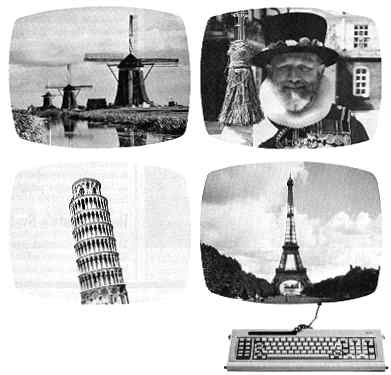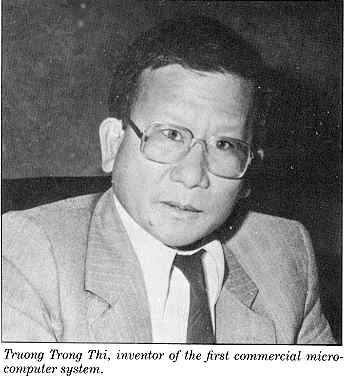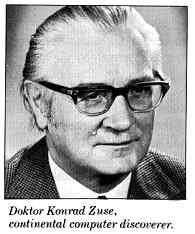
PERSONAL
COMPUTING IN
EUROPE
by Colin S. Boettcher
Colin S. Boettcher is counselor for international affairs to France's Agence de l'Informatique.
While most histories of personal computing center on its development in the United States, the world's first commercial microcomputer system must in fact be credited to Europe and an enterprising young Frenchman of Vietnamese descent. Announced in February 1973, Truong Trong Thi's Micral was built around the Intel 8008, contained 256 bytes of memory (with expansion capability up to 1K) and came with keyboard and video monitor. Although Mr. Truong presented the Micral, complete with floppy and hard disks, at the 1974 National Computer Conference in the United States, not until 1976 did an American firm agree to license his machine. When he later tried to set up his own U. S. subsidiary, Truong encountered financial difficulties that forced him finally to abandon the project.
Although personal computing in present-day Europe takes many forms, from the familiar home video games to the multifunction work stations of large corporations, two factors have slowed its progress. First, hardware and software of American origin were significantly more expensive in Europe than in the United States. Second, language constitutes a major barrier to greater American penetration of the European market. Programs and documentation in local languages are a prerequisite for the success of personal computers, especially as we descend the pyramid of users to the non-English-speaking "man in the street." This problem goes beyond translation itself, extending to different character sets: in France, Germany and Spain-indeed in most countries of Europe-diacritical marks are an integral, vital part of the written language.

Her Majesty's Systems
The United Kingdom, more advanced than the other European countries when it comes to personal computing, can boast more micros per capita than the United States. This phenomenon is attributed to Sir Clive Sinclair, inventor of the world's first pocket calculator, who in the 1970s introduced the ZX80 home computer for the equivalent of less than $100. Sir Clive then went on to offer the ZX81, widely sold in America as the Timex/Sinclair 1000, and the Spectrum with improved keyboard and full-color graphics. The Spectrum became one of the best-selling computers of all time, quickly selling over two million units in the United Kingdom, and was followed by the QL ("quantum leap") for users who wanted business-level computing at home computer prices.
Sir Clive's entrepreneurial spirit spread among the British people and gave rise to numerous small businesses in the development and support of personal computers. In addition, the highly respected British Broadcasting Corporation, which set up a series of TV programs addressing the issues of microcomputing, contracted with Acorn for a computer built to its own specifications. Used as a support for the TV programs, the Acorn/BBC micro soon had a following similar to the Apple II cult and spawned a multitude of momand-pop efforts in hardware, software, books and magazines. Financing became relatively easy to find (albeit on a more limited scale than in the United States), despite record unemployment and little confidence in the future.
British programmers, who had to squeeze the most out of machines with limited capabilities and memory, have succeeded in gaining a reputation for the quality of their software. Their programs do not travel well to other countries, however, perhaps because the elegant business software is specific to British fiscal practices or because the original entertainment software (with witty titles like Mutant Camels from Outer Space) tends to be written for machines available only in the United Kingdom.
Les Ordinateurs Individuels
Meanwhile, across the Channel, France computes to her own tune as she pursues a national goal of developing a strong domestic computer industry. Inadequate software and keyboard phobia are no longer the rule (even computer professionals were at one time reluctant to touch the keyboard for fear of losing status). Plans for government-funded installation of personal computers in schools, originally devised in the 1970s, have received new impetus. Extensive training and awareness programs have been instituted to bring the nation into the forefront of data processing both as a user and as an industry leader.
France did have successful start-ups like Goupil, born in a Paris basement with help from the telecommunications authority and reminiscent of the Apple Computer. The original Goupil ("fox"), however, was soon surpassed by other models, including the madein-France Thomson TO series from one of the nation's largest consumer electronics firms. Today the major computer manufacturer is Bull, which bought out Mr. Truong's R2E company and now markets the Micral line of state-of-the-art micros as its main offering in the field.
One contribution from the French government, a notable scheme conceived by Jean-Jacques ServanSchreiber and initiated by President Mitterrand, was the establishment of the World Center for Microcomputing and Human Resources in the midst of Paris. It was Servan-Schreiber's hope, and that of a dozen other personalities from around the world, that personal computing would ease the plight of the Third World and improve the lot of mankind in general.
The original idea was to set up a resource center, staffed by international scientists, that would be open twenty-four hours a day, seven days a week, so "the man in the street" could just walk in anytime and use the various personal computers (or ordinateurs individuels) with or without assistance. Plans were also formulated to investigate the impact of personal computers on young children in Senegal with no previous exposure to modern technologies and to observe the social effects of saturating a popular area of Marseilles with two thousand micros. The scientists ended up battling not only the formidable technical challenges but each other, however, and some of them left (including Professors Papert and Negroponte, on leave from M.I.T. to organize the project) while others were replaced. In 1983 the center was reorganized and financed by the telecommunications authority (the PTT), its aims somewhat clarified and a more realistic workplan defined.
In the meantime, France plays host to the biggest computer show in the world. SICOB is held in the modern convention hall at the Rond Point de La Defense in Paris, drawing as many as two hundred thousand attendees from all over the planet.
Across the Rhine
In Germany things are different again. Businessmen use their computers mainly in the office, so the introduction of personal computers into the home has to be justified by entirely other criteria such as cost effectiveness and task applicability.
As in France, software has been the major barrier to the rapid penetration of personal computing. Moreover, Germany has a shortage of computer professionals, and the development of amateur programming has not occurred. Computers have been introduced into schools only recently and, perhaps because of the country's federated nature, on a piecemeal basis.
Another restraining aspect has been the role of the major computer manufacturing company, Siemens, which in the early 1980s declared that personal computing would not be one of their lines of business. Nevertheless, statistics show that Germany is number two in Europe with respect to personal computers. There is also a growing emphasis on quality products. Commodore 64s are among the most popular personal computers in Germany, with a much greater number of disk drives in use (instead of slower but less expensive cassette recorders) than in any other country.
It is here, moreover, that we find some of the world's most stringent standards regarding such factors as ergonomy and man-machine interface. Indeed, the German requirements are often used as goals in the computer design practiced in other countries.
Cosmopolitan Computers
While numerous computer clubs and associations exist throughout Europe, the concept of interconnection and interreaction by means of telecommunications has not developed to the extent evidenced in the United States. This is partly because telephone facilities are more expensive to use, but also because the modems that permit such interconnection are often of American origin and not approved by the national telecommunications authorities.
For the same reasons, the world of the hacker who explores how to penetrate others' computer systems is rather limited. Although in Europe there appears to be a more developed sense of wrongdoing in this respect, awareness of the value of such intangibles as information and software is leading to the serious problem of illicit copying.
The parochial approach taken by local manufacturers is another source of difficulty in the European personal computer industry. For too long, manufacturing companies have been happy to sell a few machines to a limited market in their own region. But with the recognition, albeit slow, that an international market is involved, these same companies are having trouble finding the necessary financing to become world players. What the Europeans are also learning, the hard way, is that it is not enough to have the best product; marketing, historically a weakness, must now be exploited to the fullest.
What Europe has lost in the development of its industry has been more than made up for in the use of personal computers and interaction with other services such as videotext and electronic banking. With telecommunications and information technology now widely promoted by various governments, and with the maturation of the personal computer industry, it is to be expected that innovation rather than manufacturing will be the direction of the future.
| FRENCH (COMPUTER) LOVERS Passionate about whatever catches our fancy, whether it's wine, women or computers, we French espouse micros with an enthusiasm bordering on the fanatical. From my own observations, I believe there is no nation that surpasses our true love of l'art de la microinformatique. Consider, for example, our hackers. One friend of mine is a programmer who boasts that he can copy any software disk, no matter how ingenious the author's protection scheme. Taking him up on this challenge, another friend opened up a disk drive, inverted two wires in order to make the diskette spin backwards, and recorded a copy of a trivial program on the backwards drive. A few days later, during a visit from the programmer, he demonstrated his new software (which, of course, ran perfectly well when loaded from the doctored disk player). Then he removed the diskette and turned it over to the would-be codebreaker. Every few weeks now, when they meet at the computer shop, the programmer brings in another unsuccessful solution. My word, but he seems to be losing a lot of sleep! Because he is software-oriented, it has never occurred to him that a hardware trick might be the source of his frustration. Still, he won't give up. Cracking this diskette has become his idée fixe. Another friend is perhaps the most passionné of our computer circle. His is a very French living arrangement, wherein his estranged wife lives on the first floor of a fashionable Paris town house, his children on the second, and he and his mistress on the third. One night, over Pernod and Gauloises, he told me the following story. "I first became enamored of micros," he began, "when I discovered the Pet in Playboy. Such magnificent photographs! Front view, full disclosure ... I started to dream. Then in 1978 there appeared a French computer magazine, Microsystemes, and then a second, L'Ordinateur Individuel, and I devoured them. I toyed with the idea of writing a backgammon program that would beat top-rated players. I was fatally attracted. "Then I took a bite of my first Apple, which produced more than a few dramas at home. My daughters played Space Invaders and Apple Panic until late at night and got terrible marks in school. Eventually Popeye, my fox terrier, solved the problem. He ate their game paddles, and that was that. At last I could be alone with my new companion. "I started buying mailing list programs for my business. None of them would print two labels in a row, so I tried to break into their codes in order to rewrite them. I learned Pascal and assembly language. I bought copiers and other utility programs. I bought utilities to improve the utilities ... I didn't send a letter to a customer in five years and lost most of them! "But still that blessed computer called to me. As programs got more user-friendly, my family started to behave in a less friendly manner. Then one day my wife told me: `You'll have to choose. It's me or the computer.' I chose the latter, and today my computer is my mistress. You see, my friend, plus ça change, plus c'est la méme chose!" JEAN-LOUIS MEILLAUD, Parisian computer consultant and bridge champion |
DER EUROCOMPUTER PIONIER Fifty years ago, as a student of civil engineering, I was struck by the immense calculations that had to be performed in the construction of buildings. I became convinced that machines should be doing these calculations, but at the time I understood nothing about computers. I was not even aware of Babbage's works or of diverse parallel developments in other countries such as the United States. Deciding to try new ways, I built my own computer with the following original features: calculation of long programs controlled by a sequence of orders punched on tape (I started by using punched strips of film); use of the binary number system; introduction of floating point mathematics. I began with a strong preference for mechanical systems, but I did not succeed and was forced to switch to electromechanical technology. Finally in 1941, in my parents' Berlin apartment, I completed the Z3-the first computer of its kind in the world. My work was based mostly on private initiative, with assistance from some friends. Only after 1940 had I received sponsorship from the DVL (Deutsche Versuchsanstalt fur Luftfahrt) so that numerical problems, especially for aerodynamic applications, could be solved. During these developments, further aspects of computing became apparent. My friend Helmut Schreyer proposed the use of tubes in place of relays. This idea was a bold one. The development of the switching algebra led to a connection with mathematical logic. These new ideas extended the concept of calculation beyond numbers and gave rise to the concept of "artificial intelligence." Today we can look back on five decades of developments. Not everything that happened was intended by the computer's inventors. Even an old pioneer like me can still be surprised by the its effect. And work on the computer is far from finished. We must be prepared for further sensational innovations, with consequences that will not always be easy to master. KONRAD ZUSE, creator of the Z series of prototype computers in Germany from 1935 to 1945 |
Return to Table of Contents | Previous Article | Next Article

